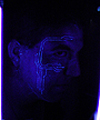 |
 |
 |
 |

Building CyberGumby
We can rebuild him ... we have the technology. Gumby (creator of the famous Polydragon tattoo) heard of a new tattoo process that used UV-Reactive Ink, which is ink that appears to glow under a blacklight. After researching its safety, he decided to get a full set of circuitry tattooed on his face and arms. He chose the UV ink alone with no additional pigment added so that it would be totally invisible under normal light. Here are the pictures of his first tattooing session: circuitry on half of his face. Afterwards, he started doing tattooing himself and is now working on the circuitry over his hands and he has added UV highlights to some of his existing tattoos.
Click on the thumbnails below to see larger images. Please do not steal these images. If you wish to copy these images, show these images on your own website or link to mine, please ask permission first. Please let me know if your name is incorrect and/or you want a link to your website at your name, and I will fix it.
Safety
What makes this ink different from standard tattoo inks, not to mention safer, is a polymer microsphere delivery vehicle. These are microscopic beads that encases the dye molecules. The technical name of this synthetic polymer is Polymethylmethacrylate, or PMMA for short. PMMA was developed for use as a shatterproof replacement for glass. For over 30 years polymethylmethacrylate (PMMA) has been used in orthopedic surgery to fix prosthetic components. PMMA has been used since the early 1930's in familiar procedures such as dental prostheses, bone repair, eye lenses, orthopedics and in pacemakers, and since 1947, when the first hip prosthesis was introduced. More recently, PMMA has been used in treatment for erasing facial wrinkles and intraocular lens implants, used to replace natural or cataract lenses of the eye. Many scientific articles on bone repair have mention the chemical inertness and biocompatibility of PMMA. Those in the tattooing and piercing industry would recognize this material as the same one that goes under brand names of Lucite and others, which is often used in plugs and other body jewelry, which is well known for its biocompatibility.
These microspheres are 4-5 times the size of a red blood cell and are well tolerated by human tissue (no rejection). In simple terms, what makes this particular tattoo ink safer than others is how the ink is manufactured. The dye color is never in contact with the person. Think of the PMMA as a safe, permanent shell surrounding the colors. These ink-filled shells actually sit in between the skin cells, with complete biocompatibility. The PMMA shell holds the color inside, and can only be broken down if frozen solid (which would mean that the person had been frozen too).
The PMMA is completely hypoallergenic, unlike some of today's tattoo inks - even the ones created with all natural organic components.
There has been some questions on the FDA related information. The Crazy Chameleon has on file a letter dated April 3, 1995 from the Division of Programs and Enforcement Policy, USFDA, and addressed the manufacturer of their ink, containing the following conclusion:
| Having reviewed the information supplied by you [our manufacturer of the ink] and your supplier ... FDA would have no objection to the use of your photonic dye marking [tattooing] system ...' |
Furthermore, the manufacturer is in the process of updating their FDA record status relating to this product. They are also seeking from said agency an additional notification that is void of any confidential or proprietary information or data and thus appropriate for release to the general public.
None of the tattoo inks currently on the market today are approved by the United States Food and Drug Administration for tattooing humans.
Are Chameleon UV Tattoo Inks Safe?
First the Technical: BMXMETRIX System-1000 ("BMX1000™") Photonic Marking Formulation is "state-of-the-art", Safe Spectral Marking Pigment (SMP)™ that has been used since 1995 safely with absolutely NO adverse reactions. It consists of the highest quality dye encapsulated and inert microscopic beads suspended in ultra-clean proprietary solution. Referred to as "photonic tags or tattoos™" the marks are created by placing these inert particles in or beneath skin tissues. It has been carefully formulated to assure biocompatibility and safety, retention and ease of administration. Under ambient ("normal") light , photonic tattoos are normal in color, but when placed by UV ("black") light, it exhibits intense fluorescence.
The ingredients of Chameleon UV Tattoo Inks: (PMMA) Polymethylmethacrylate 97.5% and microspheres of fluorescent dye 2.5% suspended in UV sterilized, distilled water with no preservatives or other additives.
The UV Inks are used just like any other tattoo ink, though a UV Blacklight Should be used to check the ongoing work.
According to manufacturer's records, this ink received USFDA approval in 1995 for use in animals, plants and fish for the purpose of tracking migration, growth patterns; breeding habits etc. No other tattoo inks have received approval in this way. Many fisheries use this ink to "mark" the fish in oceans and the ones raised to stock rivers and ponds.
Just a note: Hundreds of thousands of men, women, and children's hands have been stamped every day with fluorescent dyes for many years at major amusement parks, night clubs, and public events, with NO adverse reactions.
Listed on the MSDS Sheet as you can read for your self. If you get the ink in your eyes, flush with water. View the Full Material Safety Data Sheet Here: www.crazychameleonbodyartsupply.com
Testing shows that the only way the dyes could break down was if the PMMA Beads were completely frozen (-10° Below Zero for extended periods of time), so if you are planning to use cryopreservation (freezing your body after death - hey, don't laugh, you wanted to know if it was safe) for any reason - UV reactive tattoos should be avoided. If they did break down, the dye would act like normal tattoo inks, and the glow under blacklight would be much less. The dyes are totally organic and biocompatible, non-carcinogenic, and MRI safe.
You need a Blacklight to make the tattoo "GLOW". All the 17 colors show up in normal light. The 18th color UV Titanium White can be used on light skin tones to create virtually invisible tattoos - some light scaring may occur due to the tattooing process.
The Inn Between © 2002



































































































